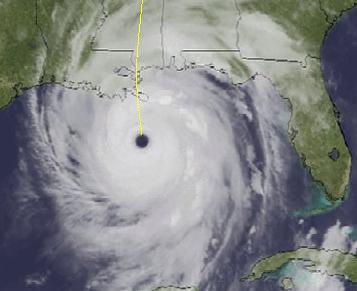Topics
GeographyHeadlinesInfrastructureKatrinaNeighborhoodsPeopleRecreation
|
 Click for Katrina at peacetakescourage.com
Click for Katrina at peacetakescourage.com
Katrina made landfall near the mouth of the River in southern Plaquemines Parish.
Veering slightly east, the eye traversed the St. Bernard wetlands and Lake Borgne. Following a
short trip across the Mississippi Sound, its destructive force blasted
into the Mississippi Gulf Coast and crushed communities from Pearl River to Pascagoula. Storm surge of over
25 feet inundated buildings within a half mile of the coast.
You are looking at a Category 5 storm in this image just before it entered cooler waters and came ashore as a high end Category 3. The eye is sixty miles wide and hurricane force winds extend 250 miles from the center. The storm reaches from Houston to St. Augustine a distance of 900 miles.
Katrina continued
inland, passing directly over Hattiesburg. Threading its way north between
Jackson and Meridian, it caused power
outages as a Category 1 storm 400 miles inland at Memphis.
Wind damage
in New Orleans was
substantial. Sustained winds
across most of the city were 80-90 miles per hour with gusts to 120 mph.
On December 21st The National Hurricane Center concluded that Katrina
came ashore as a Category 3 storm with 127 mph winds near Buras and 121
mph near the mouth of the Pearl River. Along the southern
Lake Pontchartrain shoreline the storm barely exceeded Category 1
strength although the surge was typical of a Category 2. However to the east it was more typical of a Category 4.
Unfortunately enough of this surge funneled into New
Orleans to breach some poorly maintained levees in the east and some ill conceived drainage canal levees along the lake shore. Water poured through these breaches for three days drowning half
of the city and turning a mere natural disaster into the greatest civil engineering catastrophe in American history.
One thousand eight hundred thirty three (1,833 became the official toll including 256 outside Louisiana) people died as a direct result of this storm, hundreds more have died since from stress and related disorders. Evacuation of 1.1 million people before the storm prevented a much larger death toll. Although the official damage estimate from Katrina is $81 billion, property damage, business losses, infrastructure damage and flat out destruction of an American city will cost more like $300 billion to fix. The Congressional Budget Office estimated that losses of physical capital totaled between $70 and $130 billion. In Louisiana, 45% of these losses involved business structures or equipment, including resources owned by national concerns. This $300 billion loss dwarfs the damage from other hurricanes. (Hurricane Andrew in 1992 cost $52 billion 2005 dollars)
|